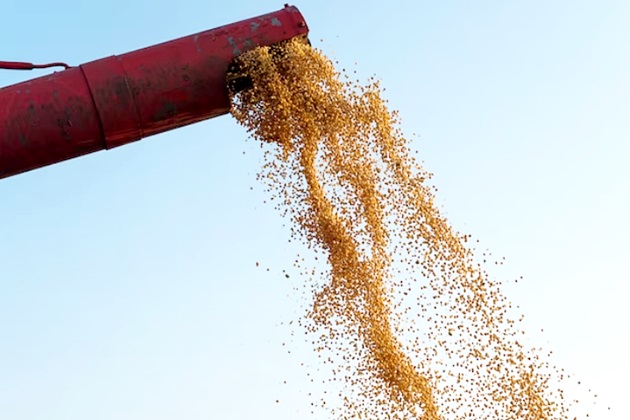
World cereal production in 2023 has increased compared to last month. Early outlook for 2024 is optimistic, indicating limited growth in wheat areas, according to the latest FAO report.
Increased Forecast
FAO's forecast for global cereal production in 2023 has been raised by 3.6 million tons this month, reflecting improved prospects for wheat and, to a lesser extent, coarse grains.
Now set at 2,823 million tons, global cereal production is expected to increase by 0.9% (25.9 million tons) from the previous year and 10.4 million tons above the previous record level reached in 2021.
The forecast for global wheat production in 2023 has been raised by about 2 million tons this month to 787 million tons but is still seen to decline by 2.1% (17.1 million tons) from the 2022 level.
The month-to-month increase is mainly related to higher yields in Russia and Turkey, where the latest official information indicates higher yields than previously anticipated.
Relatively smaller reductions in production forecasts have been made for Argentina and Brazil due to unfavorable weather conditions affecting crops at the end of the season. Global coarse grain production is set at 1,511 million tons in 2023, practically unchanged from the previous month and 3.6% above the 2022 result.
Corn Revision
A significant upward revision of corn forecasts for the United States has been made based on higher yields, offsetting production forecast declines for the European Union and Mexico, where dry weather conditions have caused localized crop losses and reduced production prospects.
FAO's forecast for global rice production in 2023/24 has increased by 0.9 million tons since November, as official assessments from Indonesia and the United Republic of Tanzania indicate that weather disruptions are likely to cause somewhat less pronounced reductions than previously anticipated. Combined with improvements in anticipated harvests from Russia, the Bolivarian Republic of Venezuela, and Vietnam, based on increased planting areas, these adjustments have raised the estimate of global rice production to 524.9 million tons (milled basis), an increase of 0.8% from 2022/23.
Lower Prices
In the outlook for the next season, winter wheat planting in 2024 is underway in northern hemisphere countries, and, reflecting lower crop prices, the increase in area could be limited this year.
In the United States, due to more favorable weather conditions this season, about 50% of the winter wheat crop was assessed as good to excellent by the end of November 2023, compared to 34% last year.
In the European Union, while planting conditions in central areas were generally favorable, excessive moisture conditions in northern and western parts hindered sowing and early crop development.
In Ukraine, ongoing constraints caused by the war, including reduced financial capacity of farmers due to low local farm gate prices and high input costs, are likely to further reduce the wheat-planted area.
In the Russian Federation, winter wheat planting was almost completed at the end of November; weather conditions improved after inadequate precipitation in southern areas in October. In India, winter wheat sowing has progressed at an average pace, and due to strong domestic prices, plantings are expected to exceed last year's level.
In Pakistan, the wheat area is estimated to slightly exceed last year's above-average level, supported by record internal prices, with adequate input supply, including water resources for irrigation, boosting yield prospects.
Against the backdrop of generally beneficial weather conditions, wheat plantings in China (mainland) were completed in October, and the sown area is estimated to be higher than the nearly average level of last year.
Rain in South America
Planting of coarse grains for 2024 is underway in southern hemisphere countries. In Brazil, due to wet weather conditions that slowed corn planting and lower prices, the total area is retracting by 5% from the record level in 2023.
In Argentina, increased precipitation has increased soil moisture levels following previous drought. With the likelihood of continued above-average rains, corn production in Argentina is scheduled to recover in 2024.
In South Africa, early conditions for planting crops in 2024 have been generally favorable; however, forecasts indicate probably drier conditions later in the season, raising concerns about yield potentials.
Total Usage
Global total cereal usage in 2023/24 is estimated at 2,813 million tons, up by 2.4 million tons from the previous month and 1.1% higher than in 2022/23. Following an upward revision of 1.9 million tons this month, global wheat usage in 2023/24 is expected to reach 791.4 million tons, surpassing the estimated level for 2022/23 by 1.8%, supported by expectations of strong growth in both feed use and other uses.
Almost unchanged from last month, the forecast for total usage of coarse grains in 2023/24 is set at 1,500 million tons, up by 1.2% from the previous season, mainly driven by increased use of corn (especially for feed and industrial uses).
World rice usage is estimated to total 521.6 million tons (milled basis) in 2023/24, only a marginal change from the previous month and 0.7 million tons below the estimate for 2022/23, as reductions in rice usage for animal feed are forecast to offset an increase driven by population growth in food consumption and other uses.
Growing Stocks
The forecast for world cereal stocks at the end of the 2024 season has been raised by 5.3 million tons from the previous month to 886.5 million tons, up by 2.7% from the opening level and marking a new record.
Based on the latest projections, the ratio of world cereal stocks to use would be 30.8% in 2023/24, almost unchanged from 30.7% in 2022/23 and indicating a comfortable supply level.
Representing the largest part of this month's upward revision, the forecast for world wheat stocks was increased by 4.2 million tons from November, mainly in Egypt, the European Union, and Saudi Arabia, and is now set at 319.3 million tons, up by 0.2% from the opening level.
Global coarse grain stocks, nearly unchanged from last month, are expected to increase by 5.7% from opening levels to 367.5 million tons. An upward revision of corn stocks this month, reflecting mainly higher projected stocks in the United States due to a higher production estimate, is likely to offset a downward revision of barley stocks, attributed mainly to lower stocks in the European Union.
FAO's forecast for global rice stocks at the end of the 2023/24 marketing seasons has been improved by 0.8 million tons, following several slight upward adjustments to carryovers, namely for Guinea, Indonesia, Myanmar, and Thailand.
As a result, world rice reserves are now estimated to increase by 1.6% from the opening level to a new peak of 199.7 million tons.
Declining Trade
Global cereal trade in 2023/24 is forecast at 468.4 million tons, a marginal decrease from last month and 1.8% lower than the 2022/23 level. At 194.1 million tons, the forecast for global wheat trade in 2023/24 (July/June) is almost unchanged from month to month.
Upward adjustments to export forecasts for Turkey and Ukraine have been offset by downward revisions to export prospects for Argentina, Brazil, and the European Union.
The forecast for global coarse grain trade in 2023/24 (July/June) is also almost unchanged from the previous forecast and still slightly (0.8%) below the 2022/23 level.
Global corn trade was marginally revised upward this month, reflecting anticipated stronger import demand from Mexico and Saudi Arabia and larger exports from Paraguay and the Russian Federation, but still sees a decline of 1.5% from 2022/23.
The forecast for international rice trade in 2024 (January/December) has been reduced by 0.6 million tons to 52.3 million tons, mainly due to a downward adjustment of imports by China, only partially offset by increased acquisitions by Indonesia.
The revised forecast would imply that global rice flows in 2024 are likely to decrease by 1.5% below the already reduced level of 2023.





